Introduction
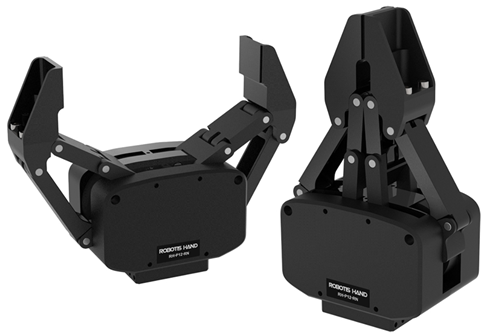
RH-P12-RN
RH-P12-RN
- It uses old firmware version.
- It has the similar control table structure to DYNAMIXEL-PRO series, so that they can be used together.
RH-P12-RN(A)
- It uses improved firmware version compared to RH-P12-RN.
- It has the similar control table structure to DYNAMIXEL-PRO(A) and DYNAMIXEL-P series, so that they can be used together.
- More information is available at RH-P12-RN(A) manual.
You can choose the desired firmware version by using Firmware Recovery of R+Manager 2.0 or DYNAMIXEL Wizard 2.0
NOTE : As DYNAMIXEL-PRO series is discontinued, using RH-P12-RN(A) Firmware version is recommended.
Specifications
| Item | Specifications |
|---|---|
| MCU | ST CORTEX-M4 (STM32F405 @ 168 Mhz, 32 bit) |
| Position Sensor | Contactless Absolute Encoder (12 bit, 360°) Maker : ams(www.ams.com), Part No : AS5045 |
| Motor | Coreless |
| Baud Rate | 9,600 bps ~ 10.5 Mbps |
| Control Algorithm | PID Control |
| Degree of Precision | 0.088° |
| Operating Mode | Current Control Mode Current based Position Control Mode |
| Weight | 500 g |
| Stroke | 0 ~ 109 mm |
| Max Closing Speed | 75 mm/s |
| Gear Ratio | 1181 : 1 |
| Maximum Gripping Force | 170 N |
| Recommended Payload | 5 kg |
| Operating Temperature | -5°C ~ 55°C |
| Nominal Voltage | 24V |
| Command Signal | Digital Packet |
| Protocol Type | RS485 Asynchronous Serial Communication (8bit, 1stop, No Parity) |
| Physical Connection | RS485 Multidrop BUS |
| ID | 0 ~ 252 |
| Feedback | Position, Velocity, Current, Temperature, Input Voltage, etc |
| Material | Full Metal Gear, Metal Body |
| Standby Current | 30 mA |
| Peak Current | 3.33 A |
Control Table
The Control Table is a data structure used by DYNAMIXEL actuators to manage the state of the device. Users can read data registers to get information about the status of the device with Read Instruction Packets, and modify data registers to control the device with Write Instruction Packets.
Control Table, Data, Address
The Control Table is a structure that consists of multiple Data fields to store status or to control the device. Users can check current status of the device by reading a specific Data from the Control Table with Read Instruction Packets. WRITE Instruction Packets enable users to control the device by changing specific Data in the Control Table. The Address is a unique value when accessing a specific Data in the Control Table with Instruction Packets. In order to read or write data, users must designate a specific Address in the Instruction Packet. Please refer to DYNAMIXEL Protocol 2.0 for more details about Instruction Packets.
NOTE : Two’s complement is applied for the negative value. For more information, please refer to Two’s complement from Wikipedia.
Area (EEPROM, RAM)
The Control Table is divided into 2 Areas. Data in the RAM Area is reset to initial values when the power is reset(Volatile). On the other hand, data in the EEPROM Area is maintained even when the device is powered off(Non-Volatile).
Data in the EEPROM Area can only be written to if Torque Enable() is cleared to ‘0’(Torque OFF).
Size
The Size of data varies from 1 ~ 4 bytes depend on their usage. Please check the size of data when updating the data with an Instruction Packet. For data larger than 2 bytes will be saved according to Little Endian.
Access
The Control Table has two different access properties. ‘RW’ property stands for read and write access permission while ‘R’ stands for read only access permission. Data with the read only property cannot be changed by the WRITE Instruction. Read only property(‘R’) is generally used for measuring and monitoring purpose, and read write property(‘RW’) is used for controlling device.
Initial Value
Each data in the Control Table is restored to initial values when the device is turned on. Default values in the EEPROM area are initial values of the device (factory default settings). If any values in the EEPROM area are modified by a user, modified values will be restored as initial values when the device is turned on. Initial Values in the RAM area are restored when the device is turned on.
Control Table of EEPROM Area
| Address | Size(Byte) | Data Name | Description | Access | Initial Value |
|---|---|---|---|---|---|
| 0 | 2 | Model Number | Model Number | R | 35073 |
| 2 | 4 | Model Information | Model Information | R | - |
| 6 | 1 | Firmware Version | Firmware Version | R | - |
| 7 | 1 | ID | DYNAMIXEL ID | RW | 1 |
| 8 | 1 | Baud Rate | Communication Speed | RW | 1 |
| 9 | 1 | Return Delay Time | Response Delay Time | RW | 250 |
| 11 | 1 | Operating Mode | Operating Mode | RW | 5 |
| 17 | 4 | Moving Threshold | Velocity Threshold for Movement Detection | RW | 10 |
| 21 | 1 | Temperature Limit | Maximum Internal Temperature Limit | RW | 80 |
| 22 | 2 | Max Voltage Limit | Maximum Input Voltage Limit | RW | 400 |
| 24 | 2 | Min Voltage Limit | Minimum Input Voltage Limit | RW | 150 |
| 26 | 4 | Acceleration Limit | Maximum Accleration Limit | RW | 255 |
| 30 | 2 | Current Limit | Maximum Current Limit | RW | 820 |
| 32 | 4 | Velocity Limit | Maximum Velocity Limit | RW | 100 |
| 36 | 4 | Max Position Limit | Maximum Position Limit | RW | 1150 |
| 40 | 4 | Min Position Limit | Minimum Position Limit | RW | 0 |
| 44 | 1 | External Port Mode 1 | External Port Mode 1 | RW | 0 |
| 45 | 1 | External Port Mode 2 | External Port Mode 2 | RW | 0 |
| 46 | 1 | External Port Mode 3 | External Port Mode 3 | RW | 0 |
| 47 | 1 | External Port Mode 4 | External Port Mode 4 | RW | 0 |
| 48 | 1 | Shutdown | Shutdown Error Information | RW | 48 |
| 49 | 2 | Indirect Address 1 | Indirect Address 1 | RW | 634 |
| 51 | 2 | Indirect Address 2 | Indirect Address 2 | RW | 635 |
| 53 | 2 | Indirect Address 3 | Indirect Address 3 | RW | 636 |
| … | 2 | Indirect Address N | Indirect Address N | RW | … |
| 559 | 2 | Indirect Address 256 | Indirect Address 256 | RW | 889 |
Control Table of RAM Area
| Address | Size(Byte) | Data Name | Description | Access | Initial Value |
|---|---|---|---|---|---|
| 562 | 1 | Torque Enable | Motor Torque On/Off | RW | 0 |
| 563 | 1 | LED Red | Red LED Intensity Value | RW | 0 |
| 564 | 1 | LED Green | Green LED Intensity Value | RW | 0 |
| 565 | 1 | LED Blue | Blue LED Intensity Value | RW | 0 |
| 590 | 2 | Position D Gain | D Gain of Position | RW | - |
| 592 | 2 | Position I Gain | I Gain of Position | RW | - |
| 594 | 2 | Position P Gain | P Gain of Position | RW | - |
| 596 | 4 | Goal Position | Target Position Value | RW | - |
| 600 | 4 | Goal Velocity | Target Velocity Value | RW | 0 |
| 604 | 2 | Goal Current | Target Current Value | RW | 0 |
| 606 | 4 | Goal Acceleration | Target Acceleration Value | RW | 0 |
| 610 | 1 | Moving | Movement Status | R | - |
| 611 | 4 | Present Position | Present Position Value | R | - |
| 615 | 4 | Present Velocity | Present Velocity Value | R | - |
| 621 | 2 | Present Current | Present Current Value | R | - |
| 623 | 2 | Present Input Voltage | Present Input Voltage | R | - |
| 625 | 1 | Present Temperature | Present Internal Temperature | R | - |
| 626 | 2 | External Port Data 1 | External Port Data 1 | R/RW | 0 |
| 628 | 2 | External Port Data 2 | External Port Data 2 | R/RW | 0 |
| 630 | 2 | External Port Data 3 | External Port Data 3 | R/RW | 0 |
| 632 | 2 | External Port Data 4 | External Port Data 4 | R/RW | 0 |
| 634 | 1 | Indirect Data 1 | Indirect Data 1 | RW | 0 |
| 635 | 1 | Indirect Data 2 | Indirect Data 2 | RW | 0 |
| 636 | 1 | Indirect Data 3 | Indirect Data 3 | RW | 0 |
| … | 1 | Indirect Data N | Indirect Data N | RW | 0 |
| 889 | 1 | Indirect Data 256 | Indirect Data 256 | RW | 0 |
| 890 | 1 | Registered Instruction | Check Reception of Instruction | R | 0 |
| 891 | 1 | Status Return Level | Select Types of Status Return | RW | 2 |
| 892 | 1 | Hardware Error Status | Hardware Error Status | R | 0 |
Control Table Description
CAUTION : Data in the EEPROM Area can only be written when the value of Torque Enable(562) is cleared to ‘0’.
Model Number(0)
This address stores model number of the device.
| Model Name | Model Number |
|---|---|
| RH-P12-RN | 35073 (0x8901) |
Firmware Version(6)
This address stores firmware version of the device.
ID(7)
The ID is a unique value in the network to identify each DYNAMIXEL with an Instruction Packet. 0~252 (0xFC) values can be used as an ID, and 254(0xFE) is occupied as a broadcast ID. The Broadcast ID(254, 0xFE) can send an Instruction Packet to all connected DYNAMIXEL simultaneously.
NOTE : Please avoid using an identical ID for multiple DYNAMIXEL. You may face communication failure or may not be able to detect DYNAMIXEL with an identical ID.
NOTE : If the Instruction Packet ID is set to the Broadcast ID(0xFE), Status Packets will not be returned for READ or WRITE Instructions regardless of the set value of Stuatus Return Level (68). For more details, please refer to the Status Packet section for DYNAMIXEL Protocol 2.0
Baud Rate(8)
Baud Rate determines serial communication speed between a controller and DYNAMIXEL.
| Value | Baud Rate |
|---|---|
| 8 | 10.5M |
| 7 | 4.5M |
| 6 | 4M |
| 5 | 3M |
| 4 | 2M |
| 3 | 1M |
| 2 | 115,200 |
| 1(Default) | 57,600 |
| 0 | 9,600 |
NOTE : Less than 3% of the baud rate error margin will not affect to UART communication.
NOTE : For the stable communication with higher Baudrate, configure USB Latency value to the lower.
USB Latency Setting
Return Delay Time(9)
If the DYNAMIXEL receives an Instruction Packet, it will return the Status Packet after the time of the set Return Delay Time(9).
Note that the range of values is 0 to 254 (0XFE) and its unit is 2 [μsec]. For instance, if the Return Delay Time(9) is set to ‘10’, the Status Packet will be returned after 20[μsec] when the Instruction Packet is received.
| Unit | Value Range | Description |
|---|---|---|
| 2[μsec] | 0 ~ 254 | Default value ‘250’(500[μsec]) Maximum value: ‘508’[μsec] |
Operating Mode(11)
Operating mode of the device can be configured. Each control mode has different characteristics so please choose appropriate mode for the application.
| Value | Operating Mode | Description |
|---|---|---|
| 0 | Current Control Mode | This mode only controls Current regardless of speed and position. |
| 1 ~ 4 | Reserved | - |
| 5(Default) | Current based Position Control Mode | This mode controls both Position and Current. |
Moving Threshold(17)
This value helps to determine whether the DYNAMIXEL is in motion or not.
If Present Velocity(615) is bigger than Moving Threshold(17) value, Moving(610) is set to ‘1’. Otherwise Moving(610) is cleared to ‘0’.
This value determines whether DYNAMIXEL is in motion or not.
| Value Range |
|---|
| 0 ~ 2,147,483,647 |
Temperature Limit(21)
This value limits operating temperature.
When the Present Temperature(625) that indicates internal temperature of DYNAMIXEL is greater than the Temperature Limit(21), the Overheating Error Bit(Bit 2) in the Hardware Error Status(892) will be set.
If Overheating Error Bit(Bit 2) is configured in the Shutdown(48) when Overheating Error occurs, Torque Enable(562) is cleared to ‘0’ and Torque will be disabled.
For more details, please refer to the Shutdown(48) section.
| Unit | Value Range | Description |
|---|---|---|
| About 1° | 0 ~ 100 | 0 ~ 100° |
CAUTION : Do not set the temperature higher than the default value. When the temperature alarm shutdown occurs, wait for 20 minutes to cool the temperature before reuse. Keep using the product with high temperature can cause severe damage to DYNAMIXEL.
Min/Max Voltage Limit(22, 24)
These values are maximum and minimum operating voltages.
When present input voltage acquired from Present Input Voltage(623) exceeds the range of Max Voltage Limit(36) and Min Voltage Limit(40), Input Voltage Error Bit(Bit 0) in the Hardware Error Status(892) will be set to ‘1’.
If Input Voltage Error Bit(Bit 0) is configured in the Shutdown(48) when Input Voltage Error occurs, Torque Enable(562) is cleared to ‘0’ and Torque will be disabled.
For more details, please refer to the Shutdown(48) section.
| Unit | Value Range | Description |
|---|---|---|
| About 0.1V | 0 ~ 400 | 0 ~ 40.0V |
Acceleration Limit(26)
This data indicates maximum value of Goal Acceleration(606).
Goal Acceleration(606) can’t be configured with any values exceeding the Acceleration Limit(26).
Attempting to write an exceeding value will result transmitting Data Limit Error(0x06) in the Error field of the Status Packet.
Goal Acceleration(606) is used in all operating mode except Current Control Mode in order to generate a target trajectory.
| Unit | Value Range |
|---|---|
| 214.577 Rev/min2 | 0 ~ 2,147,483,647 |
Current Limit(30)
This value indicates maximum current limit. [Goal Current(604)] can’t be configured with any values exceeding [Current Limit(30)].
Attempting to write an exceeding value will fail and result in receiving a Limit Error Bit from the Status Packet.
| Unit | Value Range |
|---|---|
| About 4.02 mA | 0 ~ 820 |
Velocity Limit(32)
This value indicates velocity limit.
The Goal Velocity(600) can’t exceed this value.
Attempting to write an exceeding value will fail and result in receiving a Limit Error Bit from the Status Packet.
| Unit | Value Range |
|---|---|
| 0.114 RPM | 0 ~ 2,147,483,647 |
Min/Max Position Limit(36, 40)
These values limit maximum and minimum target positions.
The Goal Position(596) can’t exceed these values.
Attempting to write an exceeding value will fail and result in receiving a Limit Error Bit from the Status Packet.
| Max Position(Close) | Min Position(Open) |
|---|---|
| 1,150 | 0 |
External Port Mode, External Port Data
External ports that can be used for various purposes are provided.
The property of each port is configured by the External Port Mode (44, 45, 46, 47) and data of external port is controlled by the External Port Data(626, 628, 630, 632).
| External Port Mode | Mode | Description |
|---|---|---|
| 0(default) | AI(Analogue Input) | Converts External Port signal to 12[bit] digital value |
| 1 | DO_PP(Digital Output Push-Pull) | Use External Port as a digital output port(3.3V level) |
| 2 | DI_PU(Digital Input Pull-Up) | Use External Port as a digital input port Floating connection will be considered as ‘1’ |
| 3 | DI_PD(Digital Input Pull-Down) | Use External Port as a digital input port Floating connection will be considered as ‘0’ |
| External Port Mode | Access | Details | Electrical Characteristics |
|---|---|---|---|
| Common | - | - | 0 ~ 3.3[V], 0 ~ 5[mA] VESD(HBM) : 2[kV] |
| 0(AI) | Read | Converts External Port signal to digital value External Data = signal x (4,095 / 3.3) |
Resolution : 12[bit] (0 ~ 4,095) |
| 1(DO_PP) | Write | 0 : Set External Port output to 0[V] 1 : Set External Port output to 3.3[V] |
Output High level(VOH) : 2.4 [V] (min) Output Low level(VOL) : 0.5 [V] (max) |
| 2(DI_PU) 3 (DI_PD) |
Read | 0: External Port input is 0[V] 1 : External Port input is 3.3[V] |
Input High level(VIH) : 2.3 [V] (min) Input Low level(VIL) : 1.0 [V] (max) Pull-Up/Down : 40 [kΩ] (typ) |
※ VESD(HBM) : ESD(Electrostatic Discharge) Voltage(human body model)
The External Port is not electrically insulated, therefore, abide by the electrical specifications.
If the electrical specification is exceeded or there is a problem with the signal connection, special caution is required because DYNAMIXEL can be damaged.
- Be careful not to cause electric shock by static electricity (ESD), short circuit, open circuit.
- Be careful not to let water or dust get into the External Port connector.
- If you are not using the External Port, remove the cable.
- To connect or disconnect the External Port, proceed with power off.
- Do not connect the GNDext pin of External Port directly to the GND pin of DYNAMIXEL connector. Noise from power may affect on the External Port.
External expansion port location and pin function
Remove bolts and cover plate to reveal External Port connector.
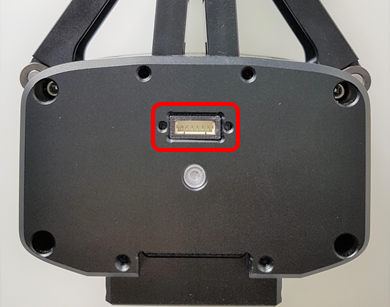

| Pin 1 | Pin 2 | Pin 3 | Pin 4 | Pin 5 | Pin 6 |
|---|---|---|---|---|---|
| GND | 3.3V | PORT1 | PORT2 | PORT3 | PORT4 |
Shutdown(48)
The DYNAMIXEL can protect itself by detecting dangerous situations that could occur during the operation. Each Bit is inclusively processed with the ‘OR’ logic, therefore, multiple options can be generated. For instance, when ‘0x05’ (binary : 00000101) is defined as Shutdown(48), DYNAMIXEL can detect both Input Voltage Error(binary : 00000001) and Overheating Error(binary : 00000100). If those errors are detected, Torque Enable(562) is cleared to ‘0’ and the motor output becomes 0[%]. In order to reuse DYNAMIXEL Pro in shutdown status, REBOOT has to be done. The followings are detectable situations.
| Bit | Item | Description |
|---|---|---|
| Bit 7 | - | Unused, Always 0 |
| Bit 6 | - | Unused, Always 0 |
| Bit 5 | Overload Error(Default) | Detect persistent load that exceeds maximum output |
| Bit 4 | Electrical Shock Error(Default) | Detect electric shock on the circuit or insufficient power to operate the motor |
| Bit 3 | Motor Encoder Error | Detect malfunction of the motor encoder |
| Bit 2 | Overheating Error | Detect internal temperature exceeds the configured operating temperature |
| Bit 1 | - | Unused, Always 0 |
| Bit 0 | Input Voltage Error | Detect input voltage exceeds the configured operating voltage |
NOTE : If Shutdown occurs, use below method to reboot DYNAMIXEL’s.
- H/W REBOOT : Turn off the power and turn on again
- S/W REBOOT : Transmit REBOOT Instruction (For more details, please refer to the [Protocol] section of e-Manual.)
Indirect Address, Indirect Data
Indirect Address and Indirect Data are useful when accessing two remote addresses in the Control Table as sequential addresses. Sequential addresses increase Instruction Packet efficiency. Addresses that can be defined as Indirect Address is limited to RAM area(Address 562 ~ 892). If specific address is allocated to Indirect Address, Indirect Address inherits features and properties of the Data from the specific Address. Property includes Size(Byte length), value range, and Access property(Read Only, Read/Write). For instance, if address 563(LED Red) is allocated to Indirect Address 1(49), Indirect Data 1(634) will have the exactly same value of LED Red(563).
Example 1
Allocating 1 byte LED(563) to Indirect Data 1(634).
- Indirect Address 1(49) : change the value to ‘563’ which is the address of LED Red.
- Set Indirect Data 1(634) to ‘1’ : LED Red(563) also becomes ‘1’ and Red LED will be turned on.
- Set Indirect Data 1(634) to ‘0’ : LED Red(563) also becomes ‘0’ and Red LED will be turned off.
Example 2
Allocating Size 4 byte Goal Position(596) to Indirect Data 2(635), 4 sequential bytes have to be allocated.
- Indirect Address 2(51) : change the value to ‘596’ which is the first address of Goal Position.
- Indirect Address 3(53) : change the value to ‘597’ which is the second address of Goal Position.
- Indirect Address 4(55) : change the value to ‘598’ which is the third address of Goal Position.
- Indirect Address 5(57) : change the value to ‘599’ which is the fourth address of Goal Position.
- Set 4 byte value 305,419,896(0x12345678) to Indirect Data 2 : Goal Position(596) also becomes 305,419,896(0x12345678) as below.
| Indirect Data Address | Goal Position Address | Saved HEX Value |
|---|---|---|
| 635 | 596 | 0x78 |
| 636 | 597 | 0x56 |
| 637 | 598 | 0x34 |
| 638 | 599 | 0x12 |
NOTE : In order to allocate Data in the Control Table longer than 2[byte] to Indirect Address, all address must be allocated to Indirect Address like the above Example 2.
NOTE : Indirect Address 29 ~ 56 and Indirect Data 29 ~ 56 can only be accessed with Protocol 2.0.
Torque Enable(562)
Torque Enable(64) determines Torque ON/OFF. Writing ‘1’ to Torque Enable’s address will turn on the Torque and all Data in the EEPROM area will be locked.
| Value | Description |
|---|---|
| 0(Default) | Torque Off |
| 1 | Torque On and lock EEPROM area |
NOTE : Present Position(611) can be reset when Operating Mode(11) and Torque Enable(562) are updated. For more details, please refer to the Homing Offset(13) and Present Position(611).
RGB LED(563)
Controls the RGB LED on DYNAMIXEL PRO.
| Address | Color | Range |
|---|---|---|
| 563 | Red | 0 ~ 255 |
| 564 | Green | 0 ~ 255 |
| 565 | Blue | 0 ~ 255 |
NOTE : The LED indicates present status of the device.
| Status | LED Representation |
|---|---|
| Booting | LED flickers once |
Position PID Gain(594, 592, 590)
These gains are used for Current-based Position Control Mode. The range of value is 0 ~ 32,767.
Below diagram illustrates position controller and current controller for Current-based Position Control Mode.
KPD, KPI and KPP stands for Position D Gain, Position I Gain and Position P Gain respectively.
When the instruction from the user is received by the gripper, it takes following steps until operating grippers.
- An Instruction from the user is transferred to the gripper, then registered to Goal Position(596).
- Goal Position(596) is converted to Target Position Trajectory and Target Velocity Trajectory by Goal Velocity(600) and Goal Acceleration(606).
- The PID controller calculates Target Current based on the Target Trajectory.
- Goal Current(604) sets a limit on the calculated Target Current to decide final Target Current.
- Current controller decides PWM output to be applied to the motor based on the final Target Current.
- The final PWM output is delivered to the motor through an Inverter, and the gripper is driven.
- Results are stored at Present Position(611), Present Velocity(615) and Present Current(621).
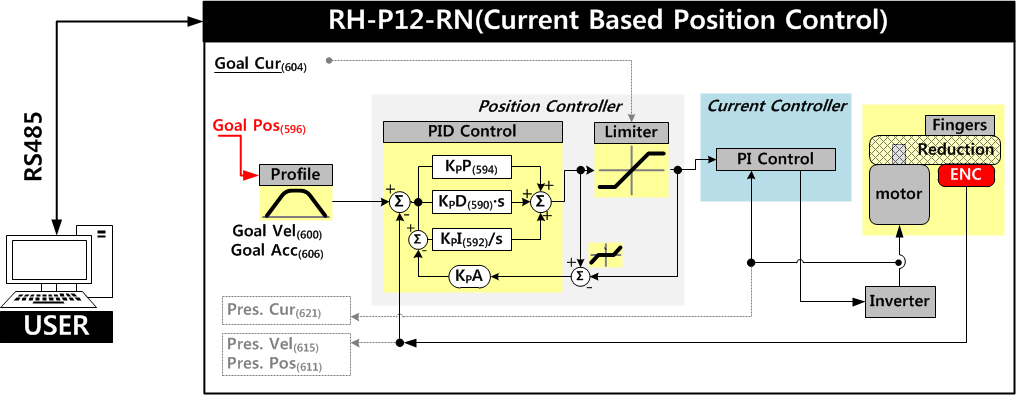
NOTE : KPA stands for Anti-windup Gain which cannot be modified by users. For more details about the PID controller, please refer to the PID Controller at wikipedia.
Goal Position(596)
This value indicates the position to move.
The range of value is between Min Position Limit(40) and Max Position Limit(36) with initial value of 0 ~ 1,150(0x47E) respectively.
| Model | Goal Position = 0 | Goal Position = 740 |
|---|---|---|
| RH-P12-RN | 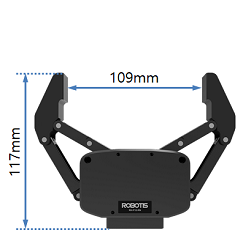 |
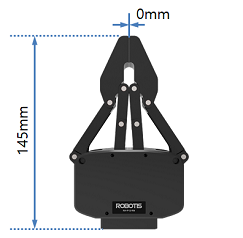 |
Goal Velocity(600)
Goal Velocity is only used for Current-based Position Control mode to set the maximum speed of Profile.
If Goal Velocity(600) is set to ‘0’, Profile is disabled and use the maximum RPM of motor.
| Unit | Value Range |
|---|---|
| 0.114 RPM | -Velocity Limit(32) ~ Velocity Limit(32) |
NOTE : The maximum velocity and maximum current of DYNAMIXEL is affected by supplying voltage. Therefore, if supplying voltage changes, so does the maximum velocity. This manual complies with recommended supply voltage(24[V]).
NOTE : Please check the maximum rpm of DYNAMIXEL. The motor cannot exceed the maximum rpm with the higher Moving Speed value.
Goal Current(604)
Goal Current is used for other purposes according to Operating Mode(11).
| Operating Mode | Goal Current |
|---|---|
| 0 (Current Control Mode) | Goal Current(604) is used as Target Current value |
| 5 (Current-based Position Control Mode) | Goal Current(604) is used as Maximum Current value |
Also, [Goal Current(604)] cannot exceed Current Limit(30).
| Unit | Value Range |
|---|---|
| about 4.02 mA | -Current Limit(30) ~ Current Limit(30) |
Goal Acceleration(606)
Goal Acceleration is only used for Current-based Position Control mode to set the acceleration of Profile.
If Goal Velocity(600) is set to ‘0’, Profile is disabled and Goal Acceleration(606) is not applied.
| Unit | Value Range |
|---|---|
| 214.577 Rev/min2 | 0 ~ Acceleration Limit(26) |
Moving(610)
This value indicates whether DYNAMIXEL PRO is in motion or not. If absolute value of Present Velocity(615) is greater than Moving Threshold(17), Moving(610) is set to ‘1’. Otherwise, it will be cleared to ‘0’. However, this value will always be set to ‘1’ regardless of Present Velocity(615) while Profile is in progress with Goal Position(596) instruction.
| Value | Description |
|---|---|
| 0 | Movement is not detected |
| 1 | Movement is detected, or Profile is in progress(Goal Position(596) instruction is being processed) |
Present Position(611)
This value indicates present Position.
| Model | Goal Position = 0 | Goal Position = 740 |
|---|---|---|
| RH-P12-RN |  |
 |
Present Velocity(615)
This value indicates present Velocity. It is a velocity to a target direction. -1,023 ~ 1,023 (0x3FF) can be used, and the conversion unit is about 0.114rpm. For more details, please refer to the Goal Velocity(600).
Present Current(621)
This value indicates present Current. The unit of this value is about 4.02mA.
Present Input Voltage(623)
This value indicates present voltage that is being supplied. For more details, please refer to the Min/Max Voltage Limit(24, 22).
Present Temperature(625)
This value indicates present internal Temperature. For more details, please refer to the Temperature Limit(21).
Registered Instruction(890)
Indicates whether the Write Instruction is registered by Reg Write Instruction
| Value | Description |
|---|---|
| 0 | No instruction registered by REG_WRITE. |
| 1 | Instruction registered by REG_WRITE exists. |
NOTE : If ACTION instruction is executed, the Registered Instruction (69) will be changed to 0.
Status Return Level(891)
The Stuatus Return Level (68) decides how to return Status Packet when DYNAMIXEL receives an Instruction Packet.
| Value | Responding Instructions | Description |
|---|---|---|
| 0 | PING Instruction | Returns the Status Packet for PING Instruction only |
| 1 | PING Instruction READ Instruction |
Returns the Status Packet for PING and READ Instruction |
| 2 | All Instructions | Returns the Status Packet for all Instructions |
NOTE : If the Instruction Packet ID is set to the Broadcast ID(0xFE), Status Packet will not be returned for READ or WRITE Instructions regardless of Stuatus Return Level (68). For more details, please refer to the Status Packet section for DYNAMIXEL Protocol 2.0.
Hardware Error Status(892)
This value indicates hardware error status. For more details, please refer to the Shutdown(48).
How to Assemble
Option Frame Assembly
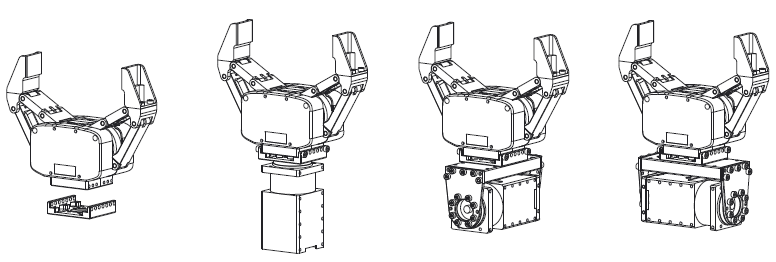
Reference
Connector Information
| Item | RS-485 | External Port |
|---|---|---|
| Pinout | 1 GND2 VDD3 DATA+4 DATA- |
1 GND2 VDD3 PORT 14 PORT 25 PORT 36 PORT 4 |
| Diagram |  |
 |
| Housing |  JST EHR-04 |
 MOLEX 51021-0600 |
| PCB Header |  JST B4B-EH-A |
 MOLEX 53047-0610 |
| Crimp Terminal | JST SEH-001T-P0.6 | MOLEX 50079-8100 |
| Wire Gauge for DYNAMIXEL | 21 AWG | 21 AWG |
Drawings
Download RH-P12-RN(PDF).zip
Download RH-P12-RN(STP).zip
Certifications
Please inquire us for information regarding unlisted certifications.
FCC
Note: This equipment has been tested and found to comply with the limits for a Class B digital device, pursuant to part 15 of the FCC Rules. These limits are designed to provide reasonable protection against harmful interference in a residential installation. This equipment generates, uses and can radiate radio frequency energy and, if not installed and used in accordance with the instructions, may cause harmful interference to radio communications. However, there is no guarantee that interference will not occur in a particular installation. If this equipment does cause harmful interference to radio or television reception, which can be determined by turning the equipment off and on, the user is encouraged to try to correct the interference by one more of the following measures:
- Reorient or relocate the receiving antenna.
- Increase the separation between the equipment and receiver.
- Connect the equipment into an outlet on a circuit different from that to which the receiver is connected.
- Consult the dealer or an experienced radio/TV technician for help.
WARNING
Any changes or modifications not expressly approved by the manufacturer could void the user’s authority to operate
the equipment.



